|
Displaying items by tag: Modernism
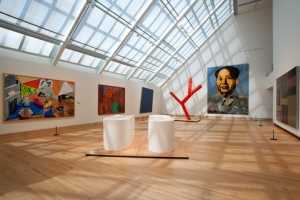
The Metropolitan Museum of Art in New York has announced plans for a major renovation of its Lila Acheson Wallace Wing. Completed in 1987, the Wing houses the museum’s Modern and contemporary collection, which includes works by the circle of early American modernists around Alfred Stieglitz, including Arthur Dove, Marsden Hartley, Georgia O'Keeffe, and John Marin; large-scale paintings by Abstract Expressionists, such as Willem de Kooning, Jackson Pollock, and Mark Rothko; and modern design, from Josef Hoffmann and members of the Wiener Werkstätte to Art Nouveau jewelry by René Lalique.
The Met, which is the largest art museum in the United States, is in the midst of re-evaluating its layout, and addressing the Lila Acheson Wallace Wing’s shortcomings is a top priority. As it stands, the Wing does not allow for a chronological presentation of the museum’s collection, creating a disjointed visitor experience. To remedy the issue, The Met plans to rebuild the Wing, potentially from scratch. Enhanced exhibition space will also allow the museum to better display its Modern and contemporary art holdings, which got a considerable upgrade last spring when philanthropist and cosmetics mogul Leonard A. Lauder donated 79 Cubist paintings, drawings, and sculptures.
From May 17 to October 2, 2014, The Irvine Museum presents Then and Now: 100 Years of Plein Air Painting, a special exhibition featuring California landscape paintings from 1903 to 2013.
The exhibition features a selection of The Irvine Museum's celebrated historic landscape paintings alongside contemporary plein air works. Works range from A Clear Day by William Wendt (c. 1903), to the most recent work featured in the exhibition, Sunset by Alexander Orlov (2013).
Featured historic artists include Benjamin Chambers Brown (1865-1942), Frank Cuprien (1871-1946), Frederick Melville DuMond (1867-1927), Euphemia Charlton Fortune (1885-1969), John Bond Francisco (1863-1932), John Frost (1890-1937), William Alexander Griffith (1866-1940), Paul Grimm (1891-1974), Sam Hyde Harris (1889-1977), Anna Hills (1882-1930), Emil Kosa, Jr. (1903-1968), and William Wendt (1865-1946).
Now that the first week of the big spring auctions is over, Sotheby’s is wasting no time touting its sales in London next month, hanging highlights in its York Avenue galleries for collectors to peruse during the contemporary-art previews this weekend.
Knowing that today’s appetite for prime abstract paintings appears boundless, Sotheby’s expects a 1927 Mondrian that has not been on the market since the 1950s to be a star of its June 23 auction. This stark canvas, “Composition With Red, Blue and Grey,” was first owned by Harry Holtzman, an artist who helped found the American Abstract Artists Group, an influential organization that espoused the principles of European Modernism, and who was a friend of Mondrian’s and an expert on his work.
Beyond the fields of lavender and honey-colored farmhouses, the land that launched a thousand fantasies is also home to another kind of delight: dazzling works of art and architecture by some of the great masters of modernism, from Picasso to Le Corbusier. Gully Wells goes on a treasure hunt.
One summer when I was a young and indolent teenager, I was packed off by my mother to stay for a week or so with some old family friends who lived in a farmhouse in the hills above Antibes on the French Riviera. Monsieur, tall with a wild bush of white hair, was a painter, and Madame, petite with olive-black eyes, was a sculptor.
"Degenerate Art" is the term Adolf Hitler and his henchmen used to describe works they simply did not like. The Nazis are long gone. Much of the art they denounced has survived, and is now on view. Here's Erin Moriarty of "48 Hours":
In the cultural capital that was Berlin in the early 1930s, art and politics often clashed, with modern artists like George Grosz leading the charge.
"Grosz was fearless, and whether it was his art or politics, he spoke his mind," said Jonathan Petropoulos, a history professor at Claremont McKenna College in California. "He was probably the most famous Communist artist in Germany at the time, and he used his art as a weapon."
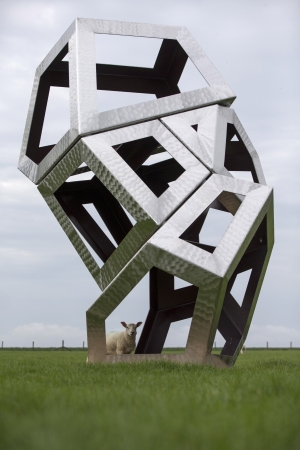
Widely considered one of the greatest sculptors of all time, British artist Henry Moore played a pivotal role in translating modernism into three dimensions. A new exhibition at the artist’s former home in Hertfordshire, England, examines the influence that Moore’s soaring, organic sculptures had on contemporary art.
“Body & Void: Echoes of Moore in Contemporary Art” presents works by some of the world’s most celebrated contemporary arts, including Damien Hirst, Rachel Whiteread, Antony Gormley, and Anish Kapoor. Works by a number of post-war artists, such as Joseph Beuys and Bruce Nauman, are also included in the exhibition. Site specific works by leading British artists Richard Deacon and Robert Long have been commissioned as part of the show.
“Body & Void” presents sculptures that examine Moore’s central themes, including the exploration of internal and external space, mother and child, and figures in a landscape, alongside contemporary works that touch on the same topics. For example, Hirst’s “Mother and Child (Divided),” a bisected cow and calf floating in giant tanks of formaldehyde, appears between Moore’s rose marble sculpture “Mother and Child” and “Stringed Mother and Child,” a single plaster cast that features two forms connected by a series of cords. The three works explore the same mother and child relationship in vastly different ways.
“Body and Void” fills the galleries and gardens at Perry Green, where Moore lived and worked for 50 years. The estate is also home to the Henry Moore Foundation, which was established by the artist in 1977. Although Moore amassed considerable wealth during his lifetime, he chose to live frugally and put most of his fortune towards endowing the Foundation, which continues to support education and promotion of the arts.
“Body & Void: Echoes of Moore in Contemporary Art” will remain on view at Perry Green through October 26.
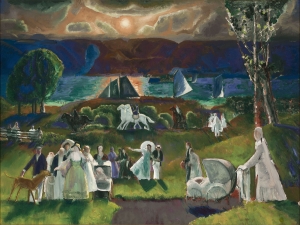
The Huntington Library, Art Collections, and Botanical Gardens in San Marino, California, has purchased two paintings by pioneering 20th-century American artists -- “Lattice and Awning” by Arthur Dove and “Summer Fantasy” by George Bellows. Dove, an early American modernist who spent most of his life in New York, was not previously represented in a public collection in Los Angeles County. The late-career landscape by Bellows, who is best known for his gritty depictions of day-to-day life, will enhance The Huntington’s collection of works by the realist painter.
Kevin Salatino, Hannah and Russell Kully Director of the Art Collections at The Huntington, said, “We have strengthened our collection of great American paintings dramatically with these acquisitions. ‘Lattice and Awning’ is a superb example of the artist’s work at a peak moment in his career, while ‘Summer Fantasy’ is a fascinating, multifaceted painting that eloquently fills a gap in our collection. Each will add invaluable depth to our display of American art.”
The works will go on view on July 19, when The Huntington opens five new rooms in its Virginia Steele Scott Galleries of American Art, which house one of the largest collections of American art in California. The Huntington’s holdings span from the colonial period through the mid-20th century and include works by John Singleton Copley, Mary Cassatt, John Singer Sargent, John Sloan, and Robert Motherwell as well as a selection of American decorative arts.
The Philadelphia Museum of Art presents the exhibition Léger: Modern Art and the Metropolis, an interdisciplinary show that sheds new light on the experimental decade of the 1920s in Paris. During that time, Fernand Léger, a French modernist painter, played an important role in redefining painting by engaging with the urban environment as well as mass media.
The cornerstone of the exhibition will be Léger’s The City (1919), which is also a pivotal part of the Philadelphia Museum of Art’s collection. The show will include other works by the artist that explore the city theme as well as film projections, theater designs, architectural models, and print and advertising designs by Léger as well as his contemporaries including Piet Mondrian, Le Corbusier and Many Ray.
Léger: Modern Art and the Metropolis, presents over 120 works, including loans from American and European public and private collections. The exhibition will be on view through January 5, 2014.
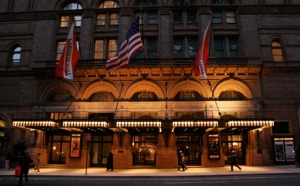
On October 3, 2013, the American Symphony Orchestra will present New York Avant-Garde at Carnegie Hall in New York. The event was organized in partnership with the New-York Historical Society’s exhibition The Armory Show at 100: Modern Art and Revolution, which opens on October 11, 2013. Led by the Symphony’s Leon Botstein, New York Avant-Garde will celebrate the 100th anniversary of the legendary 1913 Armory Show by recreating the fall-out in music caused by the groundbreaking event. The show will include works by modernist composers including Edgar Varèse and Aaron Copland.
Organized by the Association of American Painters and Sculptors, the Armory Show, officially titled the International Exhibition of Modern Art, took place at the 69th Regiment Armory and introduced radical works of art to the public; a far cry from the realistic art they were accustomed to. Artists, critics, and patrons were presented with European works that boasted avant-garde sensibilities and spanned genres like Futurism, Cubism, and Fauvism. The show transformed the landscape of modern art and inspired an unmatched growth and progression in American art.
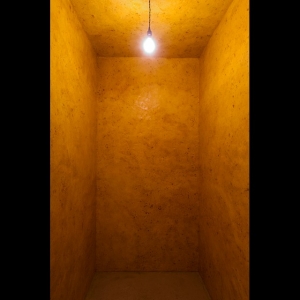
The Phillips Collection in Washington, D.C. will unveil its first permanent installation in over 50 years. Founded by the art collector and critic Duncan Phillips (1886-1966) in 1921, the Phillips Collection is the United States’ first modern art museum.
The new addition to the institution is a room made entirely from beeswax titled Wax Room. The experimental piece is the work of Wolfgang Laib (b. 1950), a conceptual German artist who is well known for his sculptural works made from natural materials. Laib has been making his beeswax chambers for over 25 years using hundreds of pounds of melted beeswax to coat walls and ceilings. The otherworldly spaces he creates are warmly lit by single hanging light bulbs.
The Phillips Collection’s other permanent installation is its Rothko Room, which holds four paintings by the abstract expressionist painter Mark Rothko (1903-1970). The intimate presentation of Rothko’s works was added as a permanent exhibit in 1960, six years before Duncan Phillips’ death. Phillips worked closely with Rothko, deciding which walls to hang each painting on and the kind of lighting and furniture that would best suit the room. The Phillips Collection was the first American museum to dedicate a space to Rothko’s work and it remains the only one designed in collaboration with the artist himself.
Laib’s progressive work is a welcomed addition to the Phillips Collection. While Phillips’ holdings consisted of many Impressionist paintings and other mainstream works, he also had a taste for the unconventional. Phillips was one of the earliest patrons of American modernists including John Marin (1870-1953) and Arthur Dove (1880-1946) and also harbored great admiration for Abstract Expressionism before it became a respected art movement.
Laib’s Wax Room will be unveiled on March 2, 2013.
|
|
|
|
|